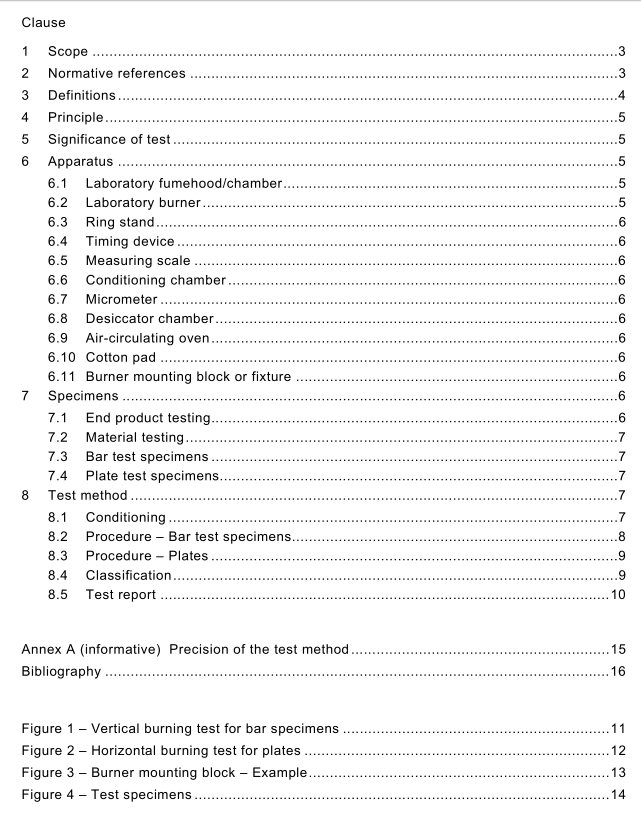AS NZS 60695.11.20 pdf download – Fire hazard testing – Part 1 1 .20: Test flames – 500 W flame test methods (IEC 60695-1 1 -20:1 999, IDT)

AS NZS 60695.11.20 pdf download Fire hazard testing – Part 1 1 .20: Test flames – 500 W flame test methods (IEC 60695-1 1 -20:1 999, IDT)
8.1 .1 Sets of five bar test specimens and three plates shall be conditioned for a minimum of 48 h at 23 °C ± 2 °C and 50 % ± 5 % relative humidity. Once removed from the conditioning chamber (see 6.6), the test specimens shall be tested within 1 h (see ISO 291 ).
8.1 .2 Sets of five bar test specimens and three plates shall be aged in the air-circulating oven (see 6.9) for 1 68 h ± 2 h at 70 °C ± 2 °C and then cooled in the desiccator chamber (see 6.8) for at least 4 h. Once removed from the desiccator chamber, the test specimens shall be tested within 30 min (see ISO 291 ).
8.1 .3 All test specimens shall be tested in a laboratory atmosphere of 1 5 °C to 35 °C and 45 % to 75 % relative humidity. 8.2 Procedure – Bar test specimens 8.2.1 Using the ring stand (see 6.3), clamp the bar test specimen using the upper 6 mm of its length with the longitudinal axis vertical so that the lower end of the bar test specimen is 300 mm ± 1 0 mm above a horizontal layer of cotton (see 6.1 0), which is approximately 50 mm × 50 mm × 6 mm uncompressed thickness and has a maximum mass of 0,08 g (see figure 1 ).
8.2.2 With the central axis of the burner tube vertical, place the burner remote from the bar test specimen and set the burner (see 6.2) to produce a standardized 500 W nominal test flame, conforming to IEC 60695-1 1 -3, flames A, B, C or D. Wait for a minimum of 5 min to allow the burner conditions to reach equilibrium. Support the burner on the burner mounting block or fixture (see 6.1 1 ), so that the burner tube is positioned at an angle of 20° ± 5° from the vertical (see figure 1 ). In case of dispute, test flame A shall be used as the reference test flame.
8.2.3 With the narrow edge of the bar test specimen facing the burner, apply the flame of the burner centrally to the lower front corner of the bar test specimen at an angle of 20° ± 5° from the vertical, so that the tip of the blue cone just touches the bar test specimen (see figure 1 ). Apply the flame for 5 s ± 0,5 s and then remove it for 5 s ± 0,5 s. Repeat the operation until the bar test specimen has been subjected to five applications of the test flame. If the bar test specimen drips particles, shrinks or elongates during the test, adjust the burner position so that the tip of the inner blue cone is just in contact with the remaining portion of the bar test specimen, ignoring any strings of molten material. Following each flame application, immediately withdraw the burner sufficiently so there is no effect on the bar test specimen.
NOTE 1 – It may be necessary to hand-hold the burner and mounting block to accomplish this.
NOTE 2 – Withdrawing the burner a distance of 1 50 mm from the bar test specimen following each flame application has been found satisfactory.
8.2.4 After the fifth application of the flame to the bar test specimen, immediately remove the burner sufficiently from the bar test specimen so that there is no effect on the bar test specimen and, simultaneously, using the timing device (see 6.4), begin measurement, to the nearest second, of the afterflame time t 1 , and the afterglow time t 2 . Note and record t 1 , t 2 , and t 1 plus t 2 . Note and record also whether any flaming particles or drops fall from the bar test specimen and, if so, whether they ignite the cotton (see 6.1 0).
NOTE 1 – Measuring and recording the afterflame time t 1 and then continuing the measurement of the sum of the afterflame time t 1 and the afterglow time t 2 , specifically t 1 plus t 2 , (without resetting the timing device) has been found satisfactory in the recording of t 2 .
NOTE 2 – Withdrawing the burner a distance of 1 50 mm from the bar test specimen while measuring t 1 and t 2 has been found satisfactory 8.2.5 Repeat the procedure until all five bar test specimens, conditioned in accordance with 8.1 .1 , and all five bar test specimens, conditioned in accordance with 8.1 .2, have been tested.









